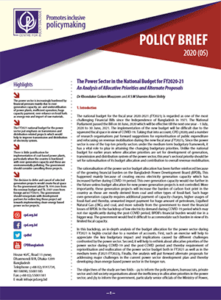
CPD Policy Brief 2020 (5)
The Power Sector in the National Budget for FY2020-21
An Analysis of Allocative Priorities and Alternate Proposals
The national budget for the fiscal year 2020-2021 (FY2021) is regarded as one of the most challenging Financial Bills since the Independence of Bangladesh in 1971. The National Parliament passed the Bill on 30 June, 2020 which will be effective till the next one year – 1 July, 2020 to 30 June, 2021. The implementation of the new budget will be difficult due to the squeezed fiscal space in view of COVID-19. Taking that into account, CPD (2020) and a number of research organisations put forward suggestions for reprioritisation of public expenditure and refocusing on revenue mobilisation during the new fiscal year (FY2021). Since the power sector is one of the top-ten priority sectors under the medium-term budgetary framework, it has a vital role to play in attaining the changing budgetary priorities. Unlike the national budget for earlier years where allocative priorities are set for development of generation, transmission and distribution system of the power sector, this year’s sectoral priority should be set for rationalisation of its budget allocation and contribution to overall revenue mobilisation.
The rationalisation of the power sector budget allocation has been further reinforced because of the growing financial burden on the Bangladesh Power Development Board (BPDB). This happened mainly because of creating excess electricity generation capacity which has increased further during COVID-19 period. This over generation capacity would rise further in the future unless budget allocation for new power generation projects is not controlled. More importantly, these generation projects will increase the burden of carbon foot print in the country as those are mostly derived from coal and other types of fossil-fuel. Such huge over-generation capacity requires additional payment of capacity charges, higher usages of fossil-fuel and thereby, unwanted import payment for huge amount of petroleum, Liquified Natural Gas (LNG) and coal, and more subsidy from the government to meet the financial losses of BPDB. In the backdrop of low electricity demand during COVID-19 period which may not rise significantly during the post-COVID period, BPDB’s financial burden would rise in a bigger way. The government would find it difficult to accommodate such burden in view of its limited fiscal capacity.
In this backdrop, an in-depth analysis of the budget allocation for the power sector during FY2021 is highly crucial due to a number of accounts. First, such an exercise will help to appreciate the key budgetary impact and implications caused by different challenges confronted by the power sector. Second, it will help to rethink about allocative priorities of the power sector during COVID-19 and the post-COVID period and thereby requirement of reprioritisation and reallocation of the power sector budget both in FY2021 as well as in the medium term (F2021-FY2023). Finally, the analysis will put forward alternate proposals for addressing major challenges in the current power sector development plan and thereby developing clean energy-based power sector in the longer run.
The objectives of the study are two folds – (a) to inform the policymakers, bureaucrats, private sector and civil society organisations about the inefficiency in allocative priorities in the power sector; and (b) to inform the government, particularly senior officials of the Ministry of Power, Energy and Mineral Resources, Ministry of Planning and Ministry of Finance, about the scope for reprioritisation of budgetary allocation in the power sector to identify scopes for releasing funds for the implementation of other important activities both within and outside the sector.
Author: Khondaker Golam Moazzem and A S M Shamim Alam Shibly
Piblication period: September 2020



